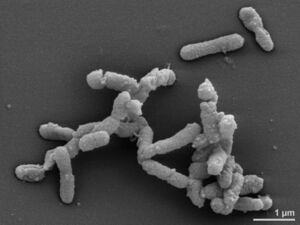Alistipes finegoldii: Difference between revisions
No edit summary |
|||
| Line 12: | Line 12: | ||
==Description and Significance== | ==Description and Significance== | ||
''Alistipes'' | ''Alistipes finegoldii'' is a gram-negative, rod-shaped, anaerobic, and non spore forming bacteria (2) that are found primarily in the gastrointestinal tract (3). This is a relatively new genus of bacteria, first discovered in tissue samples of children with appendicitis (4). So far, the ''Alistipes'' genus contains 13 species, all of which besides ''A.obesi'' are non-motile (2). The discovery of ''Alistipes'' bacteria has become essential in clinical research, as it has been shown to have both possible protective effects against diseases and pathogenetic dysbiotic effects. Studying ''Alistipes'' can provide more insight on the relationship of bacteria-host symbiosis in the gut and other areas of the body as well. Furthermore, its continuous study will contribute to how we understand ''Alistipes'' and its relationship to human health (2). | ||
==Genome Structure== | ==Genome Structure== | ||
Revision as of 04:30, 14 April 2024
Classification
Higher order taxa
Bacteria; Bacteroidota; Bacteroidia; Bacteroidales; Rikenellaceae; Alistipes (1)
Species
Alistipes finegoldii NCBI: Taxonomy
Description and Significance
Alistipes finegoldii is a gram-negative, rod-shaped, anaerobic, and non spore forming bacteria (2) that are found primarily in the gastrointestinal tract (3). This is a relatively new genus of bacteria, first discovered in tissue samples of children with appendicitis (4). So far, the Alistipes genus contains 13 species, all of which besides A.obesi are non-motile (2). The discovery of Alistipes bacteria has become essential in clinical research, as it has been shown to have both possible protective effects against diseases and pathogenetic dysbiotic effects. Studying Alistipes can provide more insight on the relationship of bacteria-host symbiosis in the gut and other areas of the body as well. Furthermore, its continuous study will contribute to how we understand Alistipes and its relationship to human health (2).
Genome Structure
Describe the size and content of the genome. How many chromosomes? Circular or linear? Other interesting features? What is known about its sequence?
Cell Structure, Metabolism and Life Cycle
Interesting features of cell structure; how it gains energy; what important molecules it produces.
Ecology and Pathogenesis
Habitat; symbiosis; biogeochemical significance; contributions to environment.
If relevant, how does this organism cause disease? Human, animal, plant hosts? Virulence factors, as well as patient symptoms.
References
Author
Page authored by Virginia Powell & Max Plodzik, students of Prof. Jay Lennon at Indiana University.

